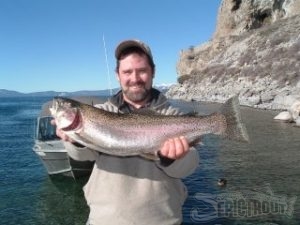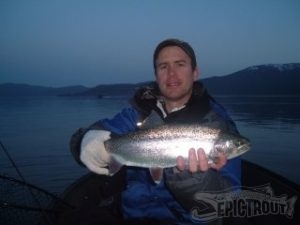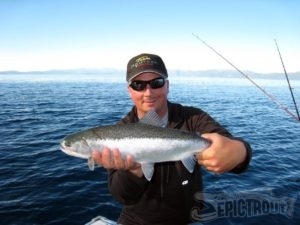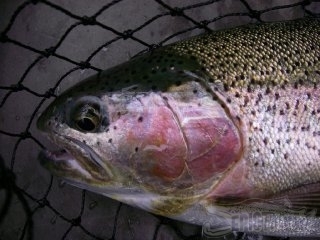Sierra steelhead
The following is a classic article Mark Wiza wrote for a west coast fishing publication a few years ago. Some things never get old though, and Mark’s tips for catching the big ‘bows of Tahoe are just as useful today. With fall topline trolling time just around the corner, it’s time to bring this great read back for a new generation of anglers here at Epic Trout!

By Mark Wiza
November 6, 2009
Autumn is a great time to visit Tahoe. The leaves of the aspen trees turn to yellow and gold, thousands of kokanee salmon in spectacular spawning colors run up Taylor Creek, and if you venture out on the lake you’ll find the hordes of summer pleasure boaters have gone. Local anglers who know the secrets of shallow water fishing on Big Blue also know that fall is prime time for hunting Tahoe’s wild and holdover rainbow trout.
While these “sierra steelhead” can be caught all year, in fifteen years of fishing for them here I’ve found the fall bite to be the most consistent. This is the result of several factors, including dropping water temperatures and shorter days that trigger the biological urge to feed heavily in order to fatten up for the long, cold winter. In addition, decreasing boat traffic on a lake that can be ridiculously busy in summer allows these shallow-water dwellers to feed and migrate freely without constantly having to dart for cover. Finally and most important, rainbow trout are spring spawners, and at that time of year many of the larger fish are moving toward or running up tributary streams, with reproduction taking priority over feeding. In autumn, adult Tahoe rainbows are furthest in the year from the need to run the creeks and reproduce, and so those big fish are roaming many areas of the lake far from feeder creeks, looking to pack back on the weight they lost to the rigors of spawning.
The general consensus among fisheries biologists and historians who study Lake Tahoe is that rainbow trout were first introduced here in the late 1800′s, and prior to the planting of rainbows, brown trout, kokanee salmon and mackinaw the only indigenous salmonid was Lahontan cutthroat trout, the Tahoe subspecies of which is now sadly extinct.

There are those however who contend that Tahoe has always had a subspecies of rainbow trout, called royal silver trout, which lived alongside the cutthroat. John Otterbain Snyder, in the 1917 edition of the Bulletin of the U.S. Bureau of Fisheries wrote an article titled “The Fishes of the Lahontan System of Nevada and Northern California” , in which he described the royal silver as a unique subspecies of rainbow, Salmo Gairdnierii Regalis, found only in Lake Tahoe.
Since that time, so many varieties of rainbow trout have been planted in the lake (including Kamloops rainbows from British Columbia and progeny of wild spawning Tahoe fish raised as broodstock by the Nevada Department of Wildlife in Marlette Lake) that if there ever was a unique Tahoe subspecies of rainbow trout, the wild rainbows we have today are most likely a genetic mix that has adapted to and thrived in this unique environment.
In addition to wild fish roaming this bi-state lake, Nevada stocks large numbers of hatchery rainbows each year at Cave Rock and Sand Harbor state parks. This year alone, according to the Nevada Department of Wildlife website, over 46,000 rainbows in the nine to twelve inch range were planted in the lake from April to August. California has not stocked the lake with rainbows for many years, but I noticed recently on the Department of Fish and Game’s website that their “Fish Stocking News” page now lists Lake Tahoe in Placer County as a planting location. No other details are given, but the most likely plant will be catchable-size rainbows, and the probable location is the Lake Forest boat ramp in Tahoe City.
Some of the hatchery rainbows are caught by shore anglers or trollers soon after being dropped in the lake, but many more disperse and then become prey for mackinaw, brown trout or even large, wild rainbows. A surprising number though survive this gauntlet of anglers and predators to hold over for several years, growing to trophy size. I have caught Tahoe rainbows five pounds and larger that fought hard, showed excellent color and displayed a full tail, yet still had at least one stunted, deformed pectoral fin or other evidence of hatchery origin. No trophy-size ‘bows are planted here, so when you catch a big one, it has spent most or all of its life chasing minnows, insects and crayfish in this incredibly pure, clear water. Fish from two to four pounds are common, and there are quite a few over five pounds lurking in the shadows of docks and boulders as well. My largest Tahoe rainbow to date is eight pounds, but fish over ten pounds have been caught by shallow water anglers.

So if you were a gambling man, looking for the best bet to hook a big Tahoe rainbow, you’d of course play the odds and fish the Nevada shoreline where the hatchery plants are heavy, right? Not necessarily. Though this fishery is certainly enhanced by contributions from the hatchery, there are big ‘bows throughout the lake, and I’ve had some great rainbow trout trips in the last few weeks many miles from the boat ramps where Nevada plants hatchery fish.
On October 4, I had the pleasure of running an instructional guide trip for Chris Branscum of Incline Village, Nevada aboard his well-equipped North River fishing boat. I met Chris and his adult sons Dean and Clark at a dock in King’s Beach on the lake’s north shore at 7:30 a.m., half-an-hour after sunrise and a late start by Tahoe standards. We had high winds and snow the night before though, and I wanted enough light to assess the wind and wave patterns on this twenty-two mile lake. Chris’ boat was a 24 footer with a 300 horsepower outboard, so I knew we’d be able to handle rough water, but boat control for trolling becomes a challenge in such conditions. An even greater concern though was that Chris had his boat on a buoy several hundred feet off shore and was using his kayak as a tender to get to his vessel. With a cold front passing through, air and water temperatures even in early fall were low enough to make hypothermia a real danger if the kayak should tip. I haven’t killed anyone yet, and I’d like to keep it that way. Though I drove through a snow-squall as I was leaving my house in South Lake Tahoe, there was just a slight chop on the water here, and Chris had made it safely out to his boat and was waiting with Dean and Clark with the boat tied to the dock when I arrived.
Chris’ boat was equipped with Cannon Mag 20 electric downriggers, but his request was that I show him some shallow water techniques to start, so I had him run for several minutes at his top speed of 40 MPH to an area with extensive rocky shallows adjacent to deep water. This is one of my favorite areas for making bait, and for hunting Tahoe rainbows. I baited my minnow trap with dry cat food and showed my clients the preferred depth and bottom structure for trapping live bait. Once we had the trap set, I began a tutorial on topline plug trolling, beginning with rod and reel choice. Chris had a set of beautiful, six-foot light action G. Loomis rods paired with Shimano Calcutta reels spooled with six-pound line. Great kokanee rods, I told him, but they lacked the backbone required for trolling large plugs at 3 MPH, and the reels did not hold enough line for long-line trolling and large trout. I opted instead to employ my 8.5 foot trolling rods with Daiwa line counter reels spooled with Fireline and a fluorocarbon topshot. The line counters take the guesswork out of fishing with the extremely long setbacks used on Tahoe, and the low-stretch superline allows for better ‘feel’ and a more solid hookset than monofilament with such a long line out behind the boat. The long rods serve a dual purpose; when set in rod holders aimed straight out to the sides of the boat and parallel to the water, they afford the angler a very wide trolling spread, which reduces tangles between the two lines on tight turns, and can even allow a third line to be trolled down the middle. In addition, big trout on Tahoe like to escape capture by hiding under your outboard motor, then circling around the lower unit, then darting to the other side of the boat and hiding there. A long rod, thrust deep into the water at the right moment, can lead that big fish away from the cover and sharp edges provided by your boat.
I then showed my clients some productive shallow trolling runs, and we had spent a couple of hours dialing in speed, depth and lure choice when the rod pulling a Rapala F18 bent over hard and the reel spat out a few yards of line against the chattering clicker. Now we had another training exercise, on what to do when you’ve hooked a large trout on light line while trolling fast. Slow the boat, clear the other line, turn out toward deeper water; my clients did well and after a few short runs and a power-dive at the boat, I scooped a twenty-two-inch rainbow trout into the net.

After high fives and photos, we checked the minnow trap and found it loaded with Lahontan redsides and crawling with crawdads as well. Time to move on to the fine art of trolling bait. I rigged lively minnows on short leaders behind Sep’s Sidekick dodgers, injected them with Pro-Cure bait oil, and we slow-trolled off a rocky point where we found nearly constant action for the next two hours. The fish were biting lightly and we had many missed strikes and stripped baits, but we also reeled in several twelve to sixteen inch hard-fighting rainbows and a small mackinaw.
The weather had cooperated until this point, but as the wind picked up from intermittent gusts to a steady, hard blow from the west, we decided to call it a day and run back to King’s Beach. This proved a wise decision, because by the time Chris had his boat back on buoy and had paddled to shore in his kayak, the lake had turned quite ugly and a flurry of snow was spitting on us sideways. Thanks for a great trip guys!

On October 16, I enjoyed a fun morning trolling Tahoe’s shallows for rainbows and brown trout with my good friend Jeff Turner aboard his 16 foot Jetcraft fishing boat. We worked the rocky shoreline areas north and south of Emerald Bay at first light, fast-trolling Rapala plugs. While this is usually an excellent low-light tactic for quality Tahoe trout, after a lure change or two and an hour without results, I suggested we check the minnow trap we had dropped at Whiskey Cove before fishing .
When we found the trap loaded with Lahontan redside shiners, speckled dace and several large crayfish, I held one jumbo minnow up in the palm of my hand and looked at Jeff in a way that had him quickly replying:
“Metal and meat; let’s do it.” He tied on a silver 4/0 Sep’s Pro dodger to troll on the outside rod, and I put a watermelon pattern Sep’s Sidekick dodger on the end of my line to run on the shoreline side. We used a sewing needle to thread live minnows onto leaders of 6 pound fluorocarbon line trailing #6 treble hooks, tied them to the dodgers, and injected my special Pro-Cure scent mixture before starting the troll.
Jeff put his electric motor in the water and turned it to high speed while I let out line until my line counter reel told me my lure was 150 feet behind the boat. Jeff stopped his drop-back at 200 feet, and used the wireless remote control hanging from a cord around his neck to slow the boat to 1 MPH.
We trolled right through the area where we had our minnow trap soaking, and this is a great tip for shallow water anglers on Tahoe. The same, rocky-bottom areas that serve as fertile minnow-trapping grounds also hold large populations of crayfish, and of course attract game fish looking for a meal as well. In addition, though chumming is illegal in California except in the Salton Sea, as the dry cat food or dog food you use for minnow bait in your trap becomes water-soaked and falls apart into the lake, besides drawing in and concentrating minnows and crayfish, your bait-trapping activities may well draw the attention of trout hunting for prey.
Now the best way to troll these dodger-minnow rigs is of course the most difficult. In order to hook Tahoe rainbows consistently this way you have to run your bait right over the rocks, bouncing off a boulder or getting hung up occasionally. The key here is the occasionally, not constantly. This is achieved by watching the fish finder closely and steering whenever possible over areas just a few feet deeper than the running depth of your lure. And how, you ask, do we know the running depth of the lure? For crankbaits and minnow plugs, there is a book called Precision Trolling, which has dive-curve charts for many popular lures developed from actual underwater observation. There’s no such reference for dodgers and flashers, but through the highly scientific testing method of getting my gear stuck on the bottom a few thousand times I have arrived at the secret of precision trolling with hardware:
The Sep’s Sidekick trolls about 15 feet deep on a straight-line troll with 150 feet of eight-pound monofilament line at 1 MPH. The larger Sep’s Pro Dodger runs a little deeper, 18 feet. If you double the amount of line out you can add about 3 more feet of depth for each lure. Yes, it’s that simple, and you’re welcome. Many anglers I share this information with are skeptical, mistakenly believing that dodgers will troll just a few feet deep, or even telling me that they have to add weight to the line to keep a dodger from popping to the surface. Slow down people! Literally, because if you can’t keep your dodger riding deep you’re going too fast.
So as Jeff zigzagged over just enough depth to keep our lures clear of the bottom, we caught and released three rainbow trout and two browns from twelve to sixteen inches. One rainbow, though in great shape, had a stunted pectoral fin that identified it as a hatchery fish. We were impressed that this little trout had migrated here all the way from Cave Rock. Did it make a ten-mile beeline straight across the lake over open water to get here? Or did it follow the shoreline and navigate thirty miles or more along Tahoe’s southern edge? Either way, this Willbury had been doing quite a bit of traveling, and we let it continue on its journey.
As the morning progressed and the sun rose high on nearly glass-calm water, the shallow bite slowed, and in that we hadn’t caught any large fish by this time, we decided to change tactics. Motoring at high speed to the southeast, we stopped at the ‘color line’, the area on the lake’s south shore where shallow, flat sand extends out into the lake for hundreds of yards before dropping nearly vertically in a series of scalloped, silt-clay cliffs that plummet to the 100 to 200 foot depth range. The local name (color line) comes from the visual effect where when you look out onto the lake on a clear, sunny day, the shallow water is a vivid aquamarine color, changing abruptly and dramatically to dark blue at the drop-off.
While this area has none of the structure such as boulder piles and sunken logs that typically attract rainbows, the dropoff nonetheless can hold large fish that use the deep side as a traveling route or as a hiding spot from which to ambush unwary prey that wanders off the shallow shelf. While shallow plugs or top lined dodgers and minnows can be productive here in low light conditions, with noon fast approaching on a cloudless day we opted to utilize lead core rods and a downrigger.
We tied Rapala plugs to our lead core leaders and put those rods in rod holders aimed straight out to each side of the boat, parallel to the water, feeding out line until our lures tapped bottom in anything less than 35 feet of water. Run this way, banging the edges of the drops and darting over deep water while trolled at 2.5 to 3 MPH, a good minnow plug can trigger strikes from big trout. I also swiveled one of Jeff’s Scotty electric downriggers straight back, and let out an AC Skinny plug on a 200 foot tether before clipping the line into the downrigger release and trying some aggressive downrigger techniques to look for treasure in the steep, deep holes in between the shallow, submerged peninsulas.

No setting the ball at a certain depth here; as Jeff zigged off the shelf I pulled the clutch on the Scotty and dropped the ball to eighty feet, banging bottom in just a few seconds. Watching the fish finder constantly, when I saw the bottom coming back up I waited until the last possible moment, then hit the retrieve button and dragged the ball up the cliff. Do not try this on areas with rocky bottoms, or with a slow downrigger. The Scotty retrieves over 200 feet per minute, and you will need every inch of this retrieve rate to employ this technique on the underwater cliffs of Tahoe.
We had been dragging the bottom this way for close to an hour without a bite, when just at the top of another drop-and-rise cycle when I had the downrigger ball set at fourteen feet to clear the tip of a shallow ‘finger’, the line popped out of the release clip but the rod stayed bent hard as line paid out freely against my reel’s lightly-set drag.
“Good Fish!” I hollered as Jeff went to work reeling in eight colors of lead core on the other two rods. My fish tangled in the line on one rod before he could get to it, and we ended up netting a bird’s nest of monofilament and lead core with a gorgeous five-pound rainbow wrapped up in the middle. Catch-and-release proved impossible, but I managed to untangle and save the lead core, and that night my wife and I enjoyed fresh filets of ruby-red sierra steelhead served with sweet potatoes and salad.
The fall fishing for Tahoe rainbows just keeps improving through Thanksgiving, with bigger fish showing in catches more frequently as the season progresses. When surface water temperatures drop into the mid to low forties, typically in December, the rainbow bite slows a bit, but by then the lake’s monster mackinaw and brown trout are off the spawn, cruising the same shallows and biting on the same lures and techniques as the rainbow trout. Shore fishing access in productive areas is limited, but large rainbows are caught from shore by dedicated anglers using light line and live minnows (only minnows from Lake Tahoe may be used as bait) or inflated night crawlers on slip-sinker rigs. Try Cave Rock State Park, Sand Harbor State Park, or for the adventurous angler, any one of the numerous paths down to the rocky shoreline between these two parks.

tahoetopliners.com/
Most of the fishing charters on Tahoe focus on deepwater trolling or jigging for mackinaw, but a few guides will take you on a shallow water trip for rainbow trout if you specifically request it (mackinaw are easier). I recommend my friend Mike Nielsen of Tahoe Topliners (530) 721-0593 for fall/winter shallow water adventures. Launch locations and hours are limited right now due to low water and locked gates at the ramps except during hours when invasive species inspectors are on duty:
Cave Rock State Park on the lake’s southeast shore and Lake Forest ramp on the northwest shore are the only public boat ramps open at this time, with short winter hours of 6:00 a.m. to 4 p.m. Private ramps with higher fees include Tahoe Keys and Obexers. At all ramps, expect to pay a fee for invasive species inspection in addition to the launch fee. Sand Harbor is closed to trailered vessel due to low water but cartop boats can launch and leave at any time without inspection. Please educate yourself as to the threat of quagga mussels, zebra mussels, and other invasive species prior to putting any boat into the lake at any access, so that you can self-inspect and help protect Lake Tahoe, our national treasure. Go to the Tahoe Resource Conservation District website (tahoercd.org) or call their Tahoe Aquatic Nuisance Species Hotline (1-888-TAHO-ANS) for more information on inspections and fees.




